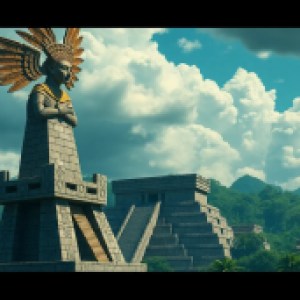The Heart of the Jungle: Mayan Mythology and Its Connection to Nature
I. Introduction
Mayan mythology is a rich tapestry of stories and beliefs that shaped the ancient Mayan civilization. It served not only as a religion but also as a way to understand the world around them. Central to these beliefs is nature, which played a pivotal role in their mythology. The Mayans viewed the natural world as a living entity, imbued with spirits and deities that influenced their daily lives, agricultural practices, and seasonal rituals.
II. The Sacred Landscape: The Mayan View of Nature
The Mayan environment is characterized by dense jungles, towering mountains, and winding rivers, all of which significantly influenced their mythology. They believed that these natural features were not just backdrops to their lives but integral components of their cosmology.
- The Jungle: The dense forests were seen as sacred spaces inhabited by spirits and gods. The lush flora and fauna represented abundance and fertility.
- The Mountains: The highlands were often associated with the gods, serving as places of worship and sacrifice.
- The Rivers: Flowing water was vital for agriculture and held symbolic meanings of life and death.
This profound connection to the land is reflected in Mayan creation myths and their understanding of the cosmos, where nature is a living, breathing entity filled with divine presence.
III. Deities of the Jungle: Gods and Goddesses Linked to Nature
The Mayans worshipped a pantheon of deities, many of whom were directly associated with natural elements. Two of the most prominent deities include:
- Chaac: The rain god, Chaac, was essential for agriculture. He was often depicted wielding an axe or a lightning bolt, symbolizing the power of rain and thunderstorms. Myths surrounding Chaac emphasize the importance of water for crops and the cycle of life.
- Ix Chel: The goddess of the moon, fertility, and medicine, Ix Chel was revered as a protector of women and childbirth. She was also associated with weaving, linking her to the nurturing aspects of nature.
These deities, among others, were central to various rituals and ceremonies that sought to appease them and ensure harmony between humans and nature.
IV. The Cycle of Life: Myths Reflecting Ecological Balance
Mayan creation myths often reflect the cyclical nature of life and the interconnectedness of all living beings. One of the most famous myths is the Popol Vuh, which tells the story of the creation of humanity and the world. It illustrates the balance between creation and destruction, life and death.
Furthermore, agricultural practices were intricately tied to seasonal changes. Key rituals included:
- Planting Ceremonies: These rituals were performed to honor the gods and ask for favorable weather and bountiful harvests.
- Harvest Festivals: Celebrations were held to give thanks for the crops and to ensure the continuation of the cycle of life.
Through these practices, the Mayans demonstrated a deep understanding of ecological balance and the need to live in harmony with their environment.
V. Animals as Symbols: The Role of Fauna in Mayan Mythology
Animals played a significant role in Mayan mythology, often serving as symbols of power, fertility, and the connection between the human and divine realms. Some key animals include:
- Jaguar: A symbol of strength and the underworld, the jaguar was revered and often associated with the night and the divine.
- Serpent: Representing rebirth and the cyclical nature of life, serpents were often depicted in myths as guardians of the earth.
- Quetzal: This beautiful bird symbolizes freedom and is associated with the god Quetzalcoatl, representing the sky and the renewal of life.
These animals not only enriched their mythology but also served as reminders of the interconnectedness of all life forms.
VI. The Underworld and Its Natural Elements: Xibalba
Xibalba, the Mayan underworld, is a complex realm filled with natural phenomena and supernatural beings. It represented death, but also the source of life, embodying the cycle of existence. In myths, Xibalba is depicted as a dark, watery place filled with challenges, representing the struggles of life.
Key aspects of Xibalba include:
- Natural Features: Rivers, mountains, and caves in Xibalba reflect the physical world, linking the underworld to the living landscape.
- Tests and Trials: The heroes in Mayan myths often faced trials in Xibalba, symbolizing the journey through life and the challenges one must overcome to achieve rebirth.
This connection between Xibalba and the natural world emphasizes the Mayan belief in the cyclical nature of existence, where death leads to new beginnings.
VII. Modern Implications: Mayan Mythology in Contemporary Environmentalism
Today, the teachings of Mayan mythology resonate with modern environmental movements. Many indigenous practices rooted in these beliefs are being revisited to inform contemporary approaches to ecology and conservation.
- Community-Based Conservation: Many indigenous groups are advocating for sustainable practices that honor their ancestral connections to the land.
- Traditional Ecological Knowledge: This knowledge, passed down through generations, provides valuable insights into biodiversity and resource management.
By integrating these ancient beliefs into modern environmentalism, there is a growing recognition of the importance of maintaining harmony with nature and the valuable lessons that Mayan mythology can offer in addressing current ecological challenges.
VIII. Conclusion
The intricate relationship between Mayan mythology and nature reveals a deep respect for the environment that continues to resonate today. The stories, rituals, and beliefs of the Mayans encapsulate a worldview where humanity is intricately tied to the natural world. As we face contemporary environmental issues, the enduring legacy of Mayan beliefs serves as a reminder of the importance of living in harmony with nature and considering the ecological balance that sustains all life.



